Vol 4 No. 7 TROPIC LIGHTNING NEWS February 17, 1969
Index
Cav Tanks, Choppers Help Bobcats,
Overrun Cong Near Tay Ninh MSR
CU CHI - Two armored platoons from the 3d Squadron, 4th Cavalry’s B Troop
recently killed 11 VC, and destroyed a battalion command post in a six-hour
battle near the village of An Duc on the main supply route to Tay Ninh.
The action began when the two platoons came to the assistance of the 1st
Battalion (Mechanized), 5th Infantry, which had been receiving heavy RPG and
automatic weapons fire from well-camouflaged bunkers.
At 3:00 p.m., the Cav troopers had positioned their tanks and armored
personnel carriers on line and proceeded to advance across an open field, broken
by thick hedgerows.
After sweeping 100 yards, they encountered heavy automatic weapons fire from
well-constructed bunkers and camouflage gun positions hidden in the hedgerows.
Gunships from the 3/4 Cav’s D Troop were called in to support the firepower of
the tanks.
Swinging to the right on line, the two armored platoons pushed through a
series of hedgerows, encountering no resistance from the first and second. But
at the third hedgerow, the horsemen met stiff grenade, automatic weapons and RPG
fire from VC bunkers and spider holes.
Breaking through the ambush, the two platoons burst into a clearing where
they faced the wreckage of a number of huts which were determined to be the
command post of a VC battalion. The huts had been destroyed by tank and gunship
firepower. Long, ragged ruts crisscrossed the ground, the remains of an
elaborate tunnel complex that had caved in under pounding from Tropic Lightning
artillery.
“Not all of the tunnels had been destroyed, however,” explained Staff
Sergeant Donald E. Clark of Tacoma, Wash. “I saw a tank moving across the
clearing at a pretty good speed. All of a sudden the ground gave way under it,
and it sank to its fenders. It was a tunnel which had withstood the arty, but
caved in under the weight of the tank.”
After searching the wreckage of the command post, the horsemen swept into a
clearing approximately 75 by 100 yards, bordered on three sides by hedgerows.
“The sun was just setting,” continued Clark, “when all of a sudden we started
getting it from everywhere. Three machinegun bunkers had opened up on us. The
VC must have fired 20 or 30 RPG rounds at us, but they kept missing our
vehicles. It was amazing!”
The troopers advanced and swung toward the MSR in a column as darkness set
in. Once again as they entered an open area boxed in by hedgerows, they
received intense hostile fire. The RTO from the first platoon, Specialist 4
Fernando Q. Herrera of San Antonio, Tex., ran through 35 yards of enemy kill
zone, throwing hand-grenades, to get to a disabled vehicle and maneuver it out
of the area.
It took an hour and a half to secure the area. The two platoons then drove
out of the bush and onto the main supply route.
Arriving at the village of An Duc, they again received hostile fire. But
preferring not to engage the enemy there, they ran through the ambush and
arrived at Fire Support Base Stewart without having lost a single vehicle.
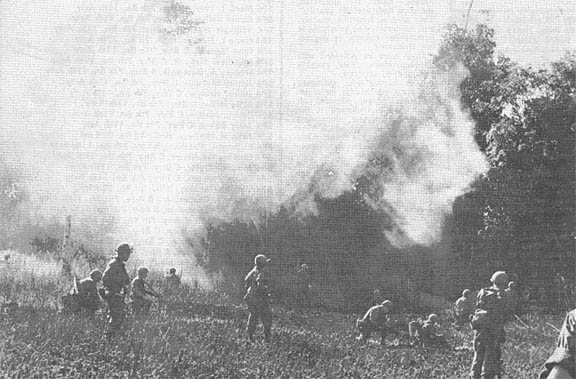 |
| THE SMOKE CLEARS - Men of the 3d Battalion, 22d Infantry prepare to search out the VC-infested jungles deep inside War Zone C. Thousands of artillery rounds and numerous air strikes have been used in this area to root out the enemy forces using the jungles as a gathering area for troops. (PHOTO BY SP4 DAVE DEMAURO) |
Regulars, Crusaders Join, Blast Enemy
By SP4 David DeMauro
TAY NINH - If you happen to wander into the jungles of War Zone C, just look
up and you’re bound to see the 3d Battalion, 22d Infantry hovering overhead
looking for a clear spot in which to land.
During the period between December 19 and January 7 the Regulars made 46
combat air assaults into the VC-NVA infested jungles northwest of Tay Ninh.
The Crusaders of the 187th Assault Helicopter Company and their Rat Pack
gunship platoon have worked in close support of the Regulars.
The Crusaders have been providing transportation for the Tropic Lightning
troops while the Rat Pack has provided the punch.
Fifteen enemy bodies have been attributed to the efforts extended by the
infantry, artillery, air strikes and helicopter gunships. Keeping the enemy
forces on the move has been the name of the game.
During the action the enemy was forced to abandon 76 large bunkers and 33
fighting positions. C Company, 3d Battalion, 22d Infantry uncovered a VC supply
depot containing three sniper rifles, two shotguns, 200 kilos of rice, 50 kilos
of salt and explosives.
Working close to Nui Ba Den Mountain, D Company discovered a huge enemy
operations control bunker. Measuring 50 feet wide and over 150 feet across, the
bunker was capable of handling operations for a regimental-sized unit.
The enemy has been kept on the run. The VC and NVA have been forced to
settle for hit-and-run activities leading to very little damage.
Lieutenant Colonel Alexander Hunt of Wealder, Tex., battalion commander,
proclaimed, “If we can keep up the tremendous pace that we have been
maintaining, it will undoubtedly continue to hamper the enemy forces. We’ve had
a great many air assault missions lately that have contributed a great deal to
our success because of the speed of mobility.
“I am extremely proud of the Crusaders and the wonderful job they have done
in support of the 3d Battalion, 22d Infantry,” Hunt added.
|
Unsafe conditions are caused by people . . . and soldiers are people. Be safety conscious, Tropic Lightning - Any Time, . . . Anywhere! |
Page 2 TROPIC LIGHTNING NEWS February 17, 1969
Decorated
| ARMY COMMENDATION MEDAL (HEROISM) | |
|
SGT Raymond C. Morgan, C Co, 2d Bn, 14th Inf |
SP4 Maurice Oyler, C Btry, 7th Bn, 11th Arty SP4 Jesus Zamora, C Btry, 7th Bn, 11th Arty SP4 Virgil L. Moxley, HHC, 3d Bn, 22d Inf SP4 Pedro T. Gamez, Jr., B Btry, 7th Bn, 11th Arty SP4 John A. Wawarnia, B Btry, 7th Bn, 11th Arty SP4 Edward Hall, C Btry, 7th Bn, 11th Arty SP4 Marshall, Dunham, C Btry, 7th Bn, 11th Arty SP4 Gregory Bagshaw, C Btry, 7th Bn, 11th Arty SP4 Sammy P. Lopez, B Btry, 7th Bn, 11th Arty SP4 Stanley A. Domanik, B Btry, 7th Bn, 11th Arty SP4 Wheeler Steedly, B Btry, 7th Bn, 11th Arty SP4 David C. D. Emery, B Btry, 7th Bn, 11th Arty SP4 Larry Thompson, B Btry, 7th Bn, 11th Arty SP4 Kenneth Wallace, C Btry, 7th Bn, 11th Arty PFC David H. Munce, HHC, 3d Bn, 22d Inf PFC John R. Arnett, Btry C, 1st Bn, 8th Arty PFC James M. Grady, HHB, 2d Bn, 77th Arty PFC Harry L. Miller, C Btry, 7th Bn, 11th Arty PFC William V. Anello, B Btry, 7th Bn, 11th Arty PFC Vernon Washington, Co A, 1st Bn, 5th Inf |
Soldier Requires Discipline For Treating Prisoners Of War
Sergeant Garrett was tempted to shoot his Vietnamese prisoner point blank.
Garrett had just seen his buddy impaled in a punji pit and was quite angry
and emotionally upset.
Then he remembered what his CO had once told him. “The man you capture is
more valuable to your mission if he is alive and well.”
WHAT TO DO
How should you treat your prisoner? The answers are found in the Geneva
Conventions, which by the way, do apply in Vietnam (“any armed conflict”).
You must treat all prisoners in the same way. A civilian police officer who
takes a suspect into custody at the scene of a crime must treat his suspect as
potentially dangerous. He must also realize there is a chance the suspect may
be entirely innocent. Likewise, you the soldier are not allowed to try, convict
and punish your prisoner.
TREATMENT
Prisoners taken by U.S. Forces must be disarmed, searched and carefully
guarded. They must be treated humanely, and not tortured or subjected to
humiliation, violence or degrading treatment.
They must be provided with adequate shelter, food, clothing and medical
attention.
After having been examined for items which may be of intelligence value,
personal effects may be returned to the detainee. Weapons, documents or other
equipment which have significant military value are processed through
intelligence channels.
You must treat all prisoners in this manner until they are delivered to a
collection point. Prisoners of war are evacuated to an ARVN prisoner of war
camp.
The only information a prisoner is required to give is his name, rank,
service number, and date of birth. You may not force more information from him,
but if he wishes to talk, pay attention to what he says.
Prisoners may retain their personal effects which are of no military value.
Helmets, gas masks and other equipment, with the exception of weaponry, issued
for personal protection remain with the owner.
While they await movement from a fighting zone, prisoners must not be exposed
to any unnecessary dangers. Medical treatment should be given at the earliest
possible moment.
ADVANTAGES
Many individuals who become prisoners of war believe that capture by Free
World Military Armed Forces means torture and death.
When humanely treated, they see that the Communist propaganda was false, and
they may become only too willing to tell interrogators everything they know.
The knowledge that they will be well treated when captured weakens the
resolve of the enemy lives on both sides, and it provides live captives who can
and will tell tales.
A word of caution: high standards of discipline are required not only of
prisoners but also of the capturing troops. Prisoners should be treated humanly
but in a business-like manner.
The status of prisoners taken in Vietnam is not a cut-and-dried matter. But
the manner in which you must treat detainees is quite simple, and if you treat
them properly it cannot help but work to our advantage.
The last thing we want to do is alienate an innocent civilian.
The first thing is to get as much truthful information as possible from enemy
prisoners. Treat your prisoner properly and, whatever his status, you will have
helped our effort in Vietnam.
Tropic Lightning Tots
The Commanding General Welcomes
The Following Tropic Lightning Tots
To The 25th Infantry Division – As
Reported By The American Red Cross.
Born To:
| Jan 20 SGT and Mrs. F.W. Hudson, HHC, 1st Bn, 5th Inf, a son, born Jan. 20. Jan 21 SP4 and Mrs. Joe Ellison, Btry C, 1st Bn, 8th Arty, a daughter Jan 22 SP4 and Mrs. Stanley Williams, Co C, 2d Bn, 27th Inf, a daughter SP4 and Mrs. Dennis G. McGee, Co A, 2d Bn, 27th Inf, a daughter SP4 and Mrs. A. Wehler, HHC 2d Bn, 12th Inf, a daughter Jan 24 SGT and Mrs. Gorge L. Torres, 25th Admin Co, a son PFC and Mrs. John S. Cornell, 25th MP Co, a son |
Jan 26 PFC and Mrs. Gerald G. Hall, Trp D, 3d Sqdn, 4th Cav, a daughter Jan 27 SP4 and Mrs. James M. Hooks, HHD, 125th Sig Bn, a son Jan 28 1LT and Mrs. Michael R. Sullivan, Co A, 2d Bn, 14th Inf, a daughter PFC and Mrs. Larry W. Fowley, Co C, 4th Bn, 23d Inf, a son Jan 30 SP4 and Mrs. Sterling M. Chandler, Co D, 1st Bn, 5th Inf, a son |
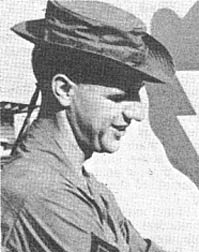 Tropic
Lightning
Tropic
Lightning
Soldier of the Month
Staff Sergeant Lloyd A. Mietzner of C Company, 3d Battalion, 22d Infantry,
has been selected Tropic Lightning Soldier of the Month. For his outstanding
performance as a combat infantryman, Mietzner was presented a $25.00 check and a
three-day pass by Lieutenant Colonel Alexander Hunt, battalion commander.
A graduate of the Ft. Benning Non-Commissioned Officers School, Mietzner has
provided outstanding leadership and courage under strenuous combat conditions.
Mietzner is the son of Mr. and Mrs. George W. Mietzner of Chebase, Ill. When
asked what he would do after he finishes his tour of duty in Vietnam, Mietzner
said, “I plan to finish college and then settle down to a good job. Vietnam has
taught me a great deal I shall never forget. I feel I understand the plight of
an underdeveloped country quite well now and have experienced a personal
growth. I hope I have contributed my share to the cause.”
Adjutant of the Regulars, Captain Hartmut Schular commented, “Staff Sergeant
Mietzner has been a tremendous asset to our unit.
The TROPIC LIGHTNING NEWS is an authorized publication of the 25th Infantry Division. It is published weekly for all division units in the Republic of Vietnam by the Information Office, 25th Infantry Division, APO San Francisco 96225. Army News Features, Army Photo Features, Armed Forces Press Service and Armed Forces News Bureau material are used. Views and opinions expressed are not necessarily those of the Department of the Army. Printed in Tokyo, Japan, by Pacific Stars and Stripes.
MG Ellis W. Williamson . . . . Commanding General
MAJ John C. Fairbank . . . . . Information Officer
2LT Don A. Eriksson . . . . . . Officer-in-Charge
SP4 Stephen Lochen . . . . . . Editor
SP4 Jim Brayer . . . . . . . . . . . . Assistant Editor
SP4 Robert C. Imler . . . . . . . . Production Supervisor
Page 3 TROPIC LIGHTNING NEWS February 17, 1969
Know Your MACV Mission, It’ll Keep You Healthy, Wise
We in Vietnam are all part of the United States Military Assistance Command (USMACV).
Our mission is two-fold; first to support the South Vietnamese in defending
against Communist insurgency and aggression; and second to assist in the
political and economic development of the nation.
USMACV is responsible for the operational control of all U.S. Armed Forces in
Vietnam, the total military advisory effort to the Army, Navy, Air Force and
Marine Corps of South Vietnam.
It is also responsible for the coordination between the South Vietnamese
Forces and the Free World Military Forces in the total effort.
The Vietnamese have paid a heavy price in material losses and human suffering
in their long fight against the Communists. We are in Vietnam now because their
government has asked us to help its soldiers and people in winning their
struggle.
The Viet Cong will attempt to turn the people against you. Nevertheless you
can defeat them at every turn by the strength, understanding, and generosity you
display with the people. Here are the ever-present nine rules:
1. Remember we are guests here. We make no demands and seek no special
treatment.
2. Join with the people. Understand their life, use phrases from their
language and honor their customs and laws.
3. Treat women with politeness and respect.
4. Make personal friends among the soldiers and common people.
5. Always give the Vietnamese the right of way.
6. Be alert to security and ready to react with your military skill.
7. Do not attract attention by loud, rude or unusual behavior.
8. Avoid separating yourself from people by a display of wealth or
privilege.
9. Above all you are members of the U.S. Military Forces on a difficult
mission, responsible for all your official and personal actions. Always reflect
honor upon yourself and the United States of America.
Your behavior is governed by a Code of Conduct which evolved from the heroic
lives, experiences and deeds of American fighting men from the Revolutionary War
to the present.
One of your personal goals as a member of the Armed Forces of the United
States is to believe unquestioningly that as an American fighting man you not
only must oppose any enemy of your country, but also that you can defeat him.
There are six points to the Code. Memorize them. You’ll be a better soldier
and a better man because of them.
1. I am an American fighting man. I serve in the forces which guard my
country and our way of life. I am prepared to give my life in their defense.
2. I will never surrender of my own free will. If in command I will never
surrender my men while they still have the means to resist.
3. If I am captured I will continue to resist by all means available. I
will make every effort to escape and aid others to escape. I will accept
neither parole nor special favors from the enemy.
4. If I become a prisoner of war, I will keep faith with my fellow
prisoners. I will give no information or take part in any action which might be
harmful to my comrades. If I am senior, I will take command. If not, I will
obey the lawful orders of those appointed over me and will back them up in every
way.
5. When questioned, should I become a prisoner, I am bound to give only
name, rank, service number and date of birth. I will evade answering further
questions to the utmost of my ability. I will make no oral or written
statements disloyal to my country and its allies or harmful to their cause.
6. I will never forget that I am an American fighting man, responsible for
my actions, and dedicated to the principles which made my country free. I will
trust in my God and in the United States of America.
Carry the seven cards that were issued to you when you came in country.
These include The Code of Conduct, the Nine Rules, Standing Orders, Rogers
Rangers, The Enemy In Your Hands, Geneva Convention ID Card, Tips on the M-16
Rifle and Tips on VC Mines.
 |
A GRENADIER from the 2d Battalion, 27th Infantry Wolfhounds fires into enemy positions near Fire Support Base Reed. The 2d Brigade soldiers uncovered clothing and enemy equipment in the area. (PHOTO BY SP4 R.B. WILLIAMS) |
PSYOPs Tests New Weapon
DAU TIENG - Thanks to a new advance in communications, allied ground
commanders are able to speak directly to enemy troops during a firefight.
The innovation, dubbed ‘Earlyword’ by members of the 6th Psychological
Operations (PSYOPs) Battalion, is being tested by the 3d Brigade near Dau Tieng.
For example, through an interpreter, an infantry commander could tell the
enemy “We know you are hiding in that treeline, alongside the road and in the
first three hootches. Surrender now.”
Such a message would be certain to unnerve the enemy and cut down his
fighting ability
Heart of the ‘Earlyword’ system is a U-10 ‘Speakerplane’ which is equipped
with a 1,000 watt amplifier. The slowly circling aircraft is already familiar
as the source of loudly broadcast taped messages and music over enemy
territory. It is also used to drop leaflets.
What is new is the addition of a radio transmitter to connect PSYOPs
personnel on the ground with the speaker system aboard the plane.
“We can react to what is taking place on the ground and influence events as
they happen. Our reaction time is reduced dramatically.”
The system is automatic, so that the plane needs only a pilot to operate ‘Earlyword.’
Lightning's First Cousin Sends Troops to RVN
TAY NINH - The first cousin of the 25th Infantry Division in Hawaii, the 29th
Brigade, Hawaiian National Guard is now sending many troops to Vietnam,
especially its company-grade officers.
Captain Tom Perry recently arrived from Scofield Barracks, birthplace of the
25th, to become assistant operations officer for the 1st Brigade.
Perry is one of 12 captains from the Hawaiian National Guard who were given
90 days to become combat ready. “This included extensive training in Hawaii and
then a tour at the Jungle Warfare School in Panama,” said Perry.
“The training was difficult, with survival tests, and simulated combat
missions in the jungles, but I feel it was well worth it. I think we are all
ready to do our jobs in Vietnam,” continued Perry.
Perry’s military career began while he was working as an industrial engineer
and attending Foothill College, Los Altos, Calif. Perry joined the California
National Guard and then attended Officer’s Candidate School, Ft. Benning, Ga.,
returning to the guard in 1964 as a second lieutenant.
Moving to Hawaii, Perry joined the Hawaiian National Guard and made First
Lieutenant. He soon became an aide to Brigadier General Fredrick A. Scaffer
III, commanding officer of the 29th Brigade.
“That was my last assignment before being promoted to Captain,” continued
Perry. “It was a very interesting and rewarding experience for me to be
associated with the General and I am looking forward to an interesting tour in
Vietnam.
Perry’s parents live in Sunnyvale, Calif., his fiancee lives in San Diego and
he has “a whole regiment” of friends in Honolulu.
Perry joins the ranks of those members of the Hawaiian National Guard who
have distinguished themselves on the battlefields of Vietnam.
VC Rice Exhumed
CU CHI - Tropic Lightning soldiers from the Fire Brigade’s 2d Battalion, 12th
Infantry, found fifteen tons of enemy rice along the banks of the Trang Bang
river during joint operations with Navy river patrol boats.
Taking to the river in huge inflatable rubber rafts, elements of the first
and third platoons of the Warrior’s Charlie Company probed the river’s edge for
hidden enemy supplies. They worked parallel to their comrades on the river bank
with two heavily armed patrol boats in midstream.
The first hint of success came when the security force on land began
searching an area around an abandoned, bamboo hootch.
“As we searched the area we found large amounts of polished rice. The more
we looked, the more we found,” said Sergeant Frank Ybarra, from Merced, Calif.
Ybarra explained that since the daylight was fading, no attempt was made to
remove the 30,000 lb. cache that day. But as food for the local populace it was
much too valuable to be destroyed.
 |
| HEAR NO EVIL, see no evil and let the mortar speak for itself. This crew, called suddenly into action, scatters to avoid the blast effects of the 4.2-inch mortar round it has just fired. From left to right, the E Company soldiers are, PFC Johnny W. Myers, Jamaica, N.Y.; PFC Donald G. Schoenberger, Walled Lake, Mich. (holding the mortar’s sighting mechanism); PFC Clarence Foster, Houston, Texas; and PFC Randy B. Thacker, Albion, Mich. The fire mission took place at the Manchus’ Fire Support Base Sedgwick, 15 miles southeast of Tay Ninh. (PHOTO BY PFC RALPH NOVAK) |
Page 4 TROPIC LIGHTNING NEWS February 17, 1969
DIVARTY’s Weather Balloons Aid Arty, Aviators’ Accuracy
CU CHI - Technicians working behind the scenes at Headquarters Battery,
Division Artillery, make effective artillery support with concise, accurate
weather data.
They also provide valuable information in aiding the forecasting of weather
throughout Vietnam.
Vital up-to-the-minute weather information for all DIVARTY units is provided
by the ten men of the DIVARTY ground meteorological section (Metro) at Cu Chi.
This information is essential for the accurate pinpoint artillery fires provided
for ground troops of Tropic Lightning.
As artillery projectiles are over the Vietnam countryside on their way to
their target, they are buffeted by winds of varying speeds blowing from various
directions and are affected by the density of the atmosphere and the
temperature.
To insure their accuracy, four times a day a hydrogen-filled balloon is sent
aloft carrying a compact transmitter called a radiosonde, which sends back
information concerning temperature, humidity and air pressure.
The path of the balloon’s ascent is tracked by a sophisticated electronic
device, the ground meteorological detector.
Metro personnel chart the balloon’s path on a plotting board from which wind
speed and direction at different altitudes are determined. This information is
incorporated into the “MET Message” which is sent to the artillery units over
radio teletype transmitter from DIVARTY RTT operators.
The MET message is decoded by the fire direction of the artillery battery and
incorporated into firing data essential for the rounds to be on target.
These weather readings are also sent to the Cu Chi Air Force Weather
Station. They are used in forecasting the weather locally and are transmitted
to Tan Son Nhut Air Base for dissemination to all weather stations in Vietnam.
These stations use the data in local forecasting and short and long range
flight planning.
Another recipient of Divarty’s metro message is the forward air control at Cu
Chi. It is imperative that fighter-bombers have the latest wind data above the
strike zone so the first bomb is on target.
| SPECIALIST 4 John J. Mooney, Chicago, operates the hydrogen generator that provides the hydrogen for the Metro balloons. Weather balloons are sent aloft four times daily from Cu Chi base camp by DIVARTY Metro section. (PHOTO BY SGT KARL GUTKNECHT) |
 |
 |
INSPECTION of the balloons is part of the job that Metro section of DIVARTY must perform. Here Specialist 4 John J. Mooney checks the 100 gram hydrogen-filled balloon to insure that it is properly filled and sealed. (PHOTO BY SGT KARL GUTKNECHT) |
| MOONEY TRACKS the balloon in flight as the radiosonde sends back information to Cu Chi concerning temperature, humidity and air pressure. (PHOTO BY SGT KARL GUTKNECHT) |
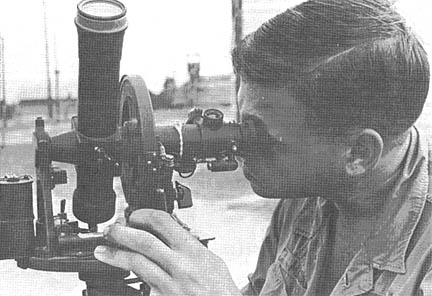 |
Warriors, Air Support Kill Nine Enemy Near Cu Chi
CU CHI - Tropic Lightning soldiers of the Fire Brigade’s 2d Battalion, 12th
Infantry Warriors killed nine enemy in a day of fierce fighting eight miles
north of Cu Chi.
The battle began as an element of Alpha Company’s 2d Platoon searched a
jungle area where bundles of freshly cut bamboo had been discovered.
The enemy opened fire from several positions in a dense tree line. The
Warriors returned fire immediately. Automatic weapons fire from the flank
alerted 1st Platoon Leader First Lieutenant Tyrone J. Staten, Gary Ind., to a
lone enemy trying to skirt the American position.
“He was running along a road carrying an AK-47 rifle,” said Staten. “My RTO
and I opened fire and got him.”
Calling for gunships and air strikes, the Warriors stayed in close,
maintaining suppressive fire while a forward air control pilot from the 2d
Brigade dropped marking grenades for the jets.
“We withdrew just long enough for the jets to do their stuff,” said the
Company A commander, First Lieutenant Richard A. Wiggins, St. Petersburg, Fla.
With close-in gunship support, the Warriors began to push through the enemy
position. But some VC were still there in what Weapons Platoon Leader First
Lieutenant Troy E. Ross, Columbia, S.C., called “the best enemy bunkers I’ve
seen in Vietnam.”
Using fire and maneuver tactics, the Warriors withdrew, bringing with them a
Communist light machine gun. Helicopters quickly extracted the Warriors.
Low-level flying gunships received enemy fire as they crisscrossed the area
to mark bunkers with smoke grenades.
More Air Force jets and heavy artillery were combined to obliterate areas of
the enemy-infested jungle.
A full-scale airmobile assault force swept into the bunker complex the next
morning. The estimated enemy platoon had fled leaving nine dead and precious
food and equipment stores.
Demolition experts from the 65th Engineer Battalion leveled what remained of
the camp.
Operations Clear Hamlet, Treat People
CU CHI - A combined operation of Company C, 2nd Battalion, 27th Infantry
Wolfhounds, one platoon of Vietnamese Regional Forces and a company of
Reconstruction and Development personnel searched and cleared the hamlet of Xom
Bao Trau near Fire Support Base Reed.
Commanded by Lieutenant Colonel Vincent J. Oddi, the operation destroyed 47
enemy bunkers with overhead cover, three spider holes and 24 tunnels.
The combined force also found 200 rounds of 7.62mm ammunition and destroyed a
dud 155mm round.
While the clearing operation was in progress, a MEDCAP team from the 2d
Brigade unit treated 48 Vietnamese.
Oddi called the operation “a complete success.”
Page 5 TROPIC LIGHTNING NEWS February 17, 1969
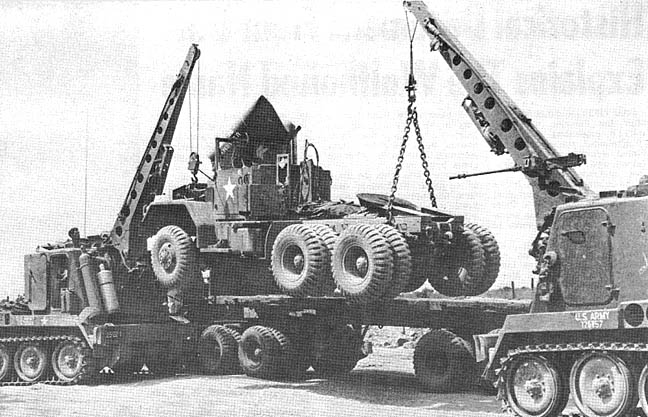 |
| TWO TRACK recovery vehicles (VTRs) hoist a deadlined tractor aboard a low-boy truck trailer in Fire Support Base Wood of the 3d Brigade. The inoperable tractor is being taken to Dau Tieng base camp for servicing by the maintenance section of the 2d Battalion (Mechanized), 22d Infantry. |
|
Story, Photos |
‘Third War’ For Triple Deuce - Maintain Combat Equipment
DAU TIENG - People often speak of two wars being carried on simultaneously in
Vietnam - the war against the enemy and the war of pacification.
Yet there is a third aspect of the war that is often unpublicized. It is the
constant struggle to maintain combat equipment and keep it in a state of maximum
readiness.
The job is especially crucial in a mechanized infantry battalion such as the
2d Battalion (Mechanized), 22d Infantry. To keep the full complement of the
‘Triple Deuce’ armored personnel carriers (APCs) performing is a never-ending
and often thankless job.
Round the clock work by men at each echelon of maintenance may be necessary to
keep the armored behemoths ready to sweep roads or charge cross country in
pursuit of the enemy.
Each company of the ‘Triple Deuce’ has its own maintenance section which
stays with the company to repair any problem which may arise in the field under
combat conditions.
The battalion maintenance section, although operating from Dau Tieng base
camp, home of the 3d Brigade also is frequently called on to go into the field.
Track recovery vehicles (VTRs) journey to fire support bases and sometimes to
the site of battles to haul back APCs that break down or are disabled. Warrant
Officer Richard S. Morrow of Nashua, N.H., the officer in charge of the
maintenance section, is attempting to provide his men with weatherproof working
facilities.
The goal is to enable the men to work without interruptions, rain or shine.
Men of the maintenance section are completing a large structure which will
provide covered areas for working on three trucks and four armored personnel
carriers at once.
Faced with a lack of readily obtained materials, Morrow hit on the expedient
of using artillery propellant cans, which were welded together into 20-foot
columns.
The propellant cans are also used to provide metal rafters. The building is
underlaid with a steel floor and covered with a steel roof.
The structure, affectionately known as the ‘Taj Mahal,’ is 100 feet long, 20
feet high and 36 feet wide. Besides the seven vehicle bays it will house a
welding shop and small engineer shop.
According to the noncomissioned officer in charge of the ‘Triple Deuce’
maintenance section, Staff Sergeant Derrell C. Young of Denver, Colo., “With
this building we can work regardless of the weather. It should help us to keep
deadlined vehicles down to a minimum.”
 |
 |
| WELDING ARTILLERY propellant cans into 20-foot columns, a ‘Triple Deuce’ mechanic works to construct the ‘Taj Mahal,’ a giant all-weather maintenance facility. The welder is Private First Class Gerad Marceaux of Gueyden, La., a member of the battalion maintenance section. | SPECIALIST 4 Lester Schmitz of Grand Forks, N.D., wields a wrench while repairing the engine of a track recovery vehicle at Triple Deuce’s ‘Tai Mahal’. |
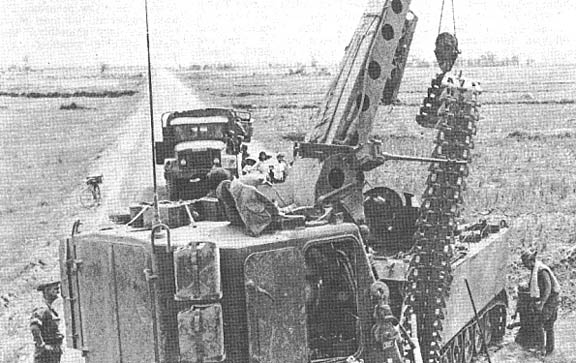 |
| RESEMBLING A HUGE SNAKE hanging from a branch, a damaged track is lifted out of the way of an armored personnel carrier which threw the track during a convoy escort five miles southwest of Dau Tieng. Picking it up is a Triple Deuce track recovery vehicle (VTR). |
Page 6 TROPIC LIGHTNING NEWS February 17, 1969
Historical Document From USA Explains The Wolfhound Name
DAU TIENG - Some 50 years after the Siberian expedition which originated the
name ‘Wolfhounds,’ members of the famed infantry unit have received new
information about their nickname.
The information comes in the form of a historical document presented to the
Army’s Chief of Military History by a member who served in Siberia in 1918 and
1919.
The document, from Mr. Nick (Hociota) Hochee of Los Angeles, was forwarded to
Lieutenant Colonel David S. Meredith of Annandale, Va., commander of the 1st
Battalion, 27th Infantry ‘Wolfhounds.’
It tells of Mr. Hochee’s service as a military policeman when the
‘Wolfhounds’ were assigned to protect the Trans-Siberian railroad during the
closing days of World War I.
In contrast to their tropical duty in Vietnam with the 25th Infantry
Division, the ‘Wolfhounds’ were operating in temperatures between 50 and 60
degrees below zero.
Hochee relates that the origin of the name ‘Wolfhounds’ dates from the
capture of a Russian youth who earlier had escaped a pack of vicious Borzoi
hounds which the Cossack Army used for hunting wolves.
After the youth was captured, he was “petrified by fear of this soldier (an
American guard) who could run faster than Kalmikoff’s Wolfhounds.”
Shortly thereafter the nickname ‘Wolfhounds’ began to be used for members of
the 27th Infantry Regiment, the 1st and 2d Battalions of which are now active.
The name became especially popular after the regiment was sent to the
Philippines in 1920 and entered into athletic competition against the 31st
Regiment, which was in garrison while the ‘Wolfhounds’ fought in Siberia.
After that, “there was no doubt that the 27th Infantry were the Wolfhounds,”
Hochee’s report says. “I know because I was there.”
Spotter Spys, Arty Reacts
DAU TIENG - Gunners of Alpha Battery, 1st Battalion, 27th Artillery, killed
three enemy after they were spotted near a suspected mortar position in the
Michelin Rubber Plantation.
A force estimated to be 16 enemy were seen running through the plantation
near Dau Tieng, 45 miles northwest of Saigon.
Sergeant First Class Max Cuczort of Bateville, Ark., an aerial observer
flying in an O-1 Bird Dog spotter plane, eyed the enemy force.
“They were dressed in green uniforms and were carrying some type of weapons,”
noted Cuczort.
As he radioed coordinates, the 155mm gunners rained down more than 20 rounds
from their position in the base camp of the 3d Brigade.
Meanwhile the pilot of the aircraft, Captain Johnnie Wilkenson of Raleigh,
N.C., circled the area to see in which direction the enemy force would flee.
Wilkenson and Cuczort were able to count three dead lying in a clearing. The
fate of the remaining enemy was unknown.
Our Truck Drivers Put In A Hard Day
TAY NINH - The infantry troops are fighting the war in Vietnam with the
support of a small group of men, the truck drivers. The truck driver has the
vital mission of getting supplies to the infantry unit no matter where they
are. Without these supplies the fighting troops cannot function.
Braving the mines, booby traps, and the elusive enemy that plague the roads
of Vietnam, the drivers move their rigs from base to base delivering their vital
cargo.
One group of drivers, members of Company D, 4th Battalion, 23d Infantry, have
their work cut out for them. The Tomahawks, a mechanized unit within the 1st
Brigade, have men and machines in three fire support bases. These bases are
resupplied every day. Most supplies are shipped by small convoys on a scheduled
basis, but in a combat situation extra supplies might be needed anytime.
“Driving these additional supplies is a hairy job. Many times I have found
myself driving the roads of the Tay Ninh area alone,” said Specialist 4 Fred
Codd, of Los Angeles.
A typical day for Codd begins with a 5 a.m. reveille, breakfast before 6:00
and on the road by 6:30. From the early morning hours to late evening, this
truck driver and his five-ton truck are on the go. His cargo consists of
anything from vital ammunition and water to food. Whatever is needed Codd will
carry.
When asked how he felt about his particular task, he said he realized the
risk but somehow the supplies had to get through.
“Sometimes I get scared, especially when I go through a village and there’s
no one else around. On a few occasions I’ve been sniped at, but most of my
trips go very smoothly,” said Codd after a grueling day’s drive.
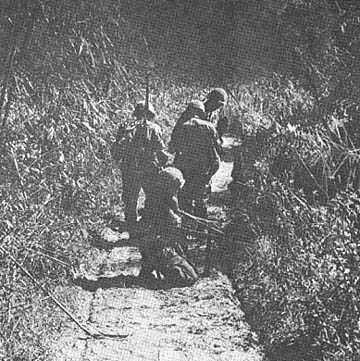 |
A LIKELY SPOT - Men of C Company, 2d Battalion, 27th Infantry carefully examine a hedgerow near Fire Support Base Reed for booby traps. The Wolfhounds must be constantly on the alert in the flat lands of III Corp for booby traps and possible munitions caches. (PHOTO BY SP4 R. B. WILLIAMS) |
Mountain MARS Radio Links Outpost & Homes
DAU TIENG - Atop a mountain outpost overlooking the Cambodian border, a G.I.
sits thinking of his girl.
“I think I’ll pick up the phone and call her up,” he says.
Minutes later the pair are happily talking across a 9,000 mile radiotelephone
hookup.
Fantastic? Not at all.
Thanks to the latest innovation of Military Affiliate Radio System (MARS)
station operators at Dau Tieng, men atop isolated Nui Ba Den, have been linked
with home.
It is the first major effort to give Tropic Lightning infantrymen living in a
field tactical situation an opportunity to call home, just as men in base camp
have been able to do for several years.
“From now on we intend to give some of the guys on top of the mountain a
chance to call home at least once a week,” said Specialist 5 Michael Jackson of
Memphis, Tenn. He is in charge of Station AB8AAC at the base camp of the 3d
Brigade.
“Our hookup takes seven radios and requires quite a bit of amplification for
both ends to be heard,” he noted. But quality was high the first day when 27 of
the mountain men got through to their loved ones.
The key to flashing the signal from atop the 3,400 foot peak to the
transmitter at Dau Tieng, 45 miles northwest of Saigon, is a very high frequency
unit coupled to a landline. They are operated by the 587th Signal Company, 86th
Signal Battalion.
Because almost everyone wanted to make a call, those atop the mountain put
names in a hat and drew out to find who would be the first to get through.
Jackson and Sergeant Dennis McDonough of Waseca, Minn., relayed the messages
to the states through MARS stations in Hawaii and at Fort Wainwright, Alaska.
Completing the hookup at 587th Signal Company were Staff Sergeants Bobby C.
Williams of Tyler, Tex., and Herbert Jones of Philadelphia, and Sergeant
Clarence Russell of Henderson, Ky.
Jackson is optimistic that eventually more infantrymen living in fire support
bases and isolated field positions will have an opportunity to call home.
“We hope to get a mobile field unit which will go to the men,” he said.
Plans call for the unit to be mounted on a truck or possibly an armored
personnel carrier, he said.
Find Bodies Near Reed II
CU CHI - Tropic Lightning soldiers from C Company, 2d Battalion, 27th
Infantry Wolfhounds turned up five enemy bodies near Fire Support Base Reed II.
Several days earlier, the 2d Brigade soldiers were sweeping the area and were
engaged by enemy small arms and RPGs. The Wolfhounds pulled back to let
artillery pound the enemy positions.
After the artillery attack, a sweep of the enemy position uncovered no
bodies. It wasn’t until days later that the Wolfhounds were able to determine
the result of the artillery strike.
Page 7 TROPIC LIGHTNING NEWS February 17, 1969
Young Cong Victim Walks Again
CU CHI - In 1966 Tran Van Bao stepped on a Viet Cong mine. For a child of
10, arms and legs are means of expression - running, laughing, waving. Since
1966 Bao hasn’t been able to express himself in those ways.
Initial treatment at the 12th Evacuation Hospital in Cu Chi allowed the child
to return to his home in Soui Cut hamlet to face the rest of his life, minus a
leg, minus a hand.
Two years followed; he managed fairly well on the bamboo crutches the
villagers made for him, though in time he grew too big for them.
Bao is not the only child afflicted by the hazards of war in Vietnam, not
even in Soui Cut, but one of many. Yet he may be an example of what can be done
for Vietnam’s abused youth. For a man saw Bao and cared.
When the Bau Dieu District pacification festival took place in November,
Colonel Eugene M. Lynch, Green Bay, Wisc., former commander of the 2d Brigade
saw and met the child and was touched by his disability.
A father of seven children, Colonel Lynch knew the look in the eyes of the
child and he saw him linger while others laughed and played. The commander
picked the boy up in his arms and carried him to an Army doctor in charge of a
Medical Civic Action center at the festival and asked for help.
Captain John C. Richards of Schenectady, N.Y., a doctor in the 12th Evac’s
children ward took care of Bao and got him a new set of cushioned crutches.
Captain Richard Laaken, Chester, Pa., 25th Medical Battalion operations officer,
coordinated Bao’s transfer to a Vietnamese hospital at Nhi Dong and the boy’s
training with an artificial limb.
Officers of the 2d Brigade headquarters donated the money for the limb and
the former brigade civic action officer, Major Calvin Sivinson of Bangor, Maine,
and his successor Major Billy May of Baylou La Batre, Ala., helped monitor and
foster the program.
Since the beginning Bao knew he had friends, even though he did not
understand why. But that concern has enabled him to return to school on his
own, to carry his own load.
Today he walks without crutches. He is still not agile, but in time he will
run and play.
Best of all, Bao is only the first. The interest generated by this project
has begun an effort that may provide similar help for hundreds of amputees.
With Vietnamese and United States support these children will be given the
chance to live a more normal and productive life.
|
Story, Photos By |
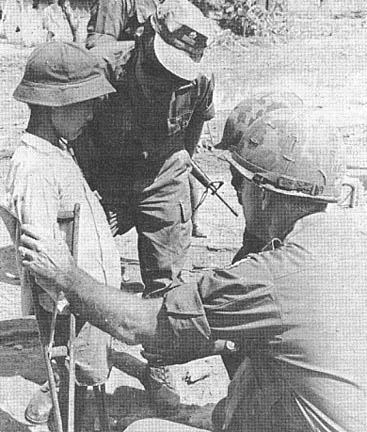 |
AT CU CHI’S 12th Evac Hospital Bao got new cushioned crutches to replace the homemade bamboo ones he used for two years. Captain Richard Laaken, Chester, Pa., 25th Medical Detachment operations officer, helped coordinate the project. |
| IN HIS MIND there were questions, but the looks of concern and interest explained much, and he waited in wards, clinics and corridors until they sent him home walking. |
 |
 |
THE FIRST STEP - When Colonel Eugene M. Lynch, Green Bay Wisc., saw Bao, he was touched by the child’s affliction. He paved the way for Bao and many others like him. With Colonel Lynch are Nguyen Xuan, Bau Dieu District advisor, and Captain Nguyen Dinh Dai, ARVN liaison of the 2d Brigade. |
| WITH TWO LEGS TO STAND ON Bao is closer to a normal life than he ever expected. While he undergoes a time of transition, plans are being made which may give other children this same chance. |
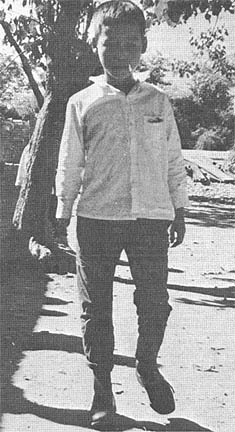 |
Page 8 TROPIC LIGHTNING NEWS February 17, 1969
MEDCAP Comes To Villagers Even As Cong Bullets Fly
TAY NINH - An airborne medical civic-action team from the 1st Brigade, and
the 3d Battalion, 22d Infantry, conducted a MEDCAP under fire at Phuoc Tan
Outpost 20 miles southwest of Tay Ninh City near the Cambodian border.
As a helicopter landed the first half of the team at the outpost, the VC
opened up with rocket-propelled grenades, automatic weapons fire and mortars.
The team scrambled for cover in the Popular Forces compound as the helicopter
strafed the source of enemy fire, a woodline 600 yards away.
Soon another chopper brought the rest of the MEDCAP team, enabling two
choppers to riddle the VC with their M-60 machine guns.
“When we go on a MEDCAP like this, we usually expect a small amount of
peaceful excitement, but nothing like this,” said Major Clarence M. De Young of
San Diego, Calif., 1st Brigade civic-action officer.
Major De Young, an artillery officer, used his training to direct artillery.
“I never dreamed I’d be doing this,” said De Young. “I just turned my radio to
the correct frequency, called in the necessary data and before long artillery
was coming in, right on target.”
During the three hours the outpost was under fire, the MEDCAP team treated
villagers who had taken refuge in the outpost. “We examined over 75 patients,
some of them Cambodians who had come across the border just to see us,” said
Captain Alden Sweatman, from Columbia, S.C., battalion surgeon.
Shortly after the last patient had been treated, the VC retreated and the
copters returned for the MEDCAP team.
“This action today is a good example of how effective our pacification
program has become,” said De Young. “Our intelligence reports had indicated the
VC might be waiting for us to try to stop our string of highly successful MEDCAPs.
But we showed them that we will continue to aid the people as much as we can
despite their threats and attempts to stop us.”
| UNDER FIRE - MEDCAP team loads up fast to make a hasty exit. The team took off only after more than 75 patients had been treated. They experienced Viet Cong harassment fire throughout the MEDCAP operation. (PHOTO BY SP4 DAVE JACKSON) | 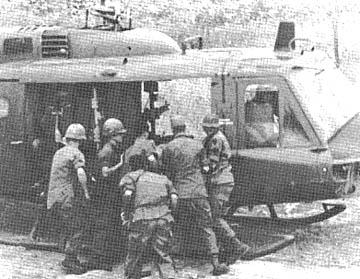 |
Wolfhounds Score On Rainy Ambush
CU CHI - Second Brigade Wolfhounds detained one enemy soldier, killed one and
detained another in a deadly close ambush near Fire Support Base Reed.
“It was rainy and miserable,” recalled Specialist 4 Arthur Eden of Portland,
Ore. “It was the darkest night I have ever experienced on an ambush patrol,” he
said.
The 1st Platoon of Charlie Company had set up in a hedgerow complex around a
suspected enemy meeting place and settled down to watch for Charlie.
Eden had been scanning the area to his front with a starlight scope and had
seen no movement, so he lowered it from his eye for a moment.
“That’s when I saw them,” the Tropic Lightning soldier said. “There were
four or five of them moving up to my left.”
The enemy walked to within ten feet of Eden’s position and stopped to look
over the area.
“I could hear them whispering and was afraid they would see our position,” he
continued. “We had very little cover and I knew I couldn’t wait much longer, so
I nudged the other men in the position; then I rolled over to get a clear field
of fire, and I opened up.”
“Eden hurt them the most,” said Lieutenant David K. Lininger, the platoon
leader from Dillsburg, Pa. “He put his first fire right on them. They only had
time to fire one AK burst, and it was all over.”
Those enemy that could, scattered. Artillery from A Battery, 1st Battalion,
8th Artillery, was called in immediately on the suspected NVA locations.
A sweep of the area at first light revealed one NVA body, one wounded
suspect, three sets of web gear, one brand new 9mm Chicom pistol and one AK 47
rifle. Several blood trails were also found.
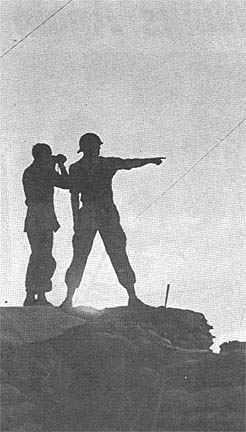 |
OVER THERE - First Lieutenant Jim Collinson of Annapolis, Md., assumes a classic stance as he points out the exact spot of enemy movement to First Lieutenant Perry T. Schelnman of Cleveland, Ohio. Schelnman is a Forward Observer for C Battery, 1st Battalion, 8th Artillery at Fire Support Base Keene III. (PHOTO BY SP4 E.R. JAMES) |
Admin Fish Story Not All Bull
“Fellas. Oh fellas, uh . . . there’s a catfish walking out in front of the
office.”
“Uh huh.”
“Righto.”
“Roger that.”
“No, seriously. There’s a catfish in front of the office walking in the
mud.”
“How many have you had tonight Ferguson?”
It wasn’t easy for Specialist 5 William Ferguson of Lake Zurick, Ill., to
persuade his fellow workers that he was actually seeing what he was actually
seeing. Was it any wonder that First Lieutenant Ronald Stern of Richmond, Tex.,
questioned Ferguson about his sobriety?
Undaunted by the derision from his co-workers, the Tropic Lightning finance
clerk persisted until he managed to get his friends to witness the creature.
After leading them to the spot, Ferguson watched the other finance men stand
in amazement, just as he had done moments before. The thing was about eight
inches long and “was crawling or wriggling through the mud,” explained Ferguson.
Identification was finally made by Captain George T. Beckett of Richmond,
Ky., who produced a magazine containing a photograph of the thing.
It’s called a morocato and is a native of Africa. It is amphibious,
breathing water through its gills and air through a complicated organ near its
gills.
The animal is nocturnal and feeds on land as well as in the water, eating
worms, insects, frogs or anything it can swallow whole. (It should thrive in
Vietnam.)
But how did it get to Vietnam?
It could have walked or swum perhaps, or maybe it was imported; but there is
no doubt at least one is here.
The little wriggler might be a welcome addition to the Vietnamese
countryside. Anyway, how much trouble can an eight inch fish-thing cause? Not
much perhaps, but in Africa, the morocato sometimes grows to a weight of 50
pounds.
| FIRST PRIZE? - Specialist 5 William Ferguson, a Tropic Lightning finance clerk, displays a recent catch. Ferguson captured the fish as it was crawling on the ground near his office. (PHOTO BY SP5 LARRY WEIST) |
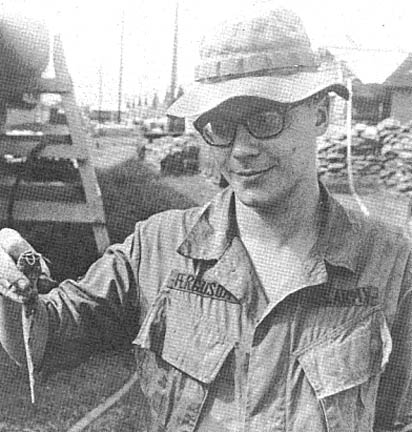 |
Thanks to:
Roger Welt, 4th Bn., 23rd Inf., and a Tropic Lightning News correspondent,
for sharing this issue,
Kirk Ramsey, 2nd Bn., 14th Inf. for creating this page.
This page last modified 01-25-2006
©2006 25th Infantry Division Association. All rights reserved.